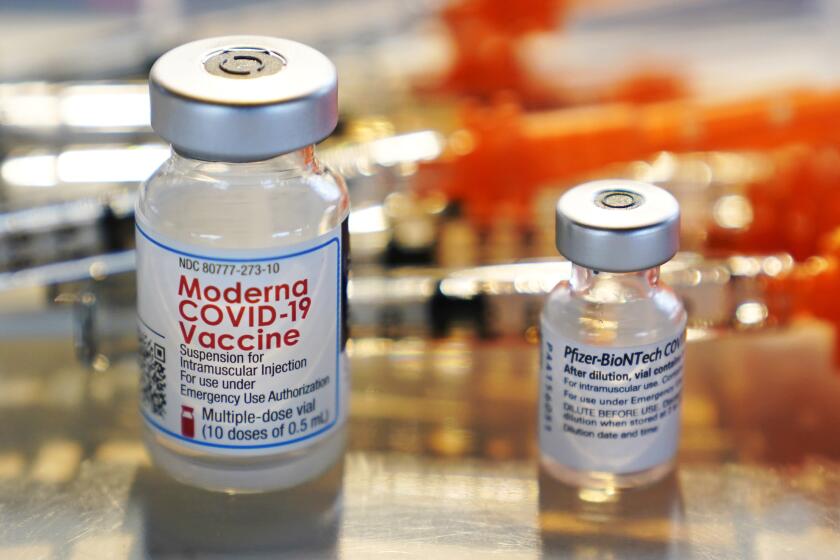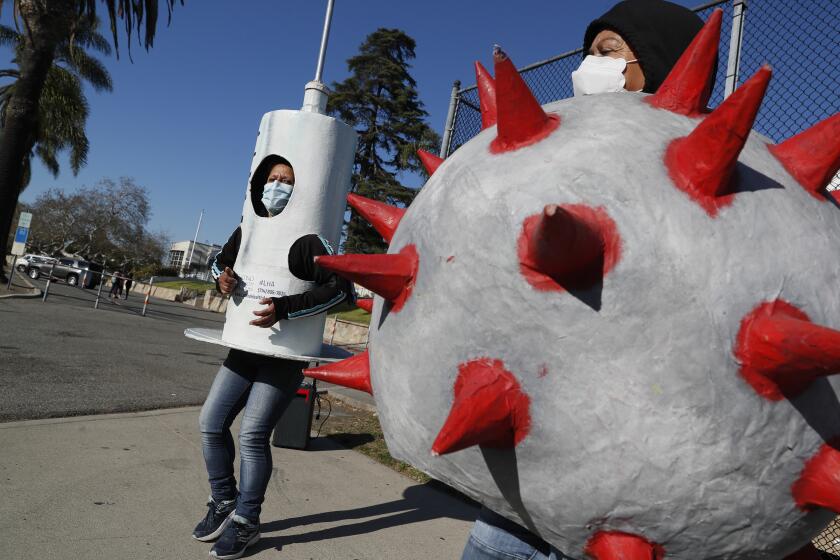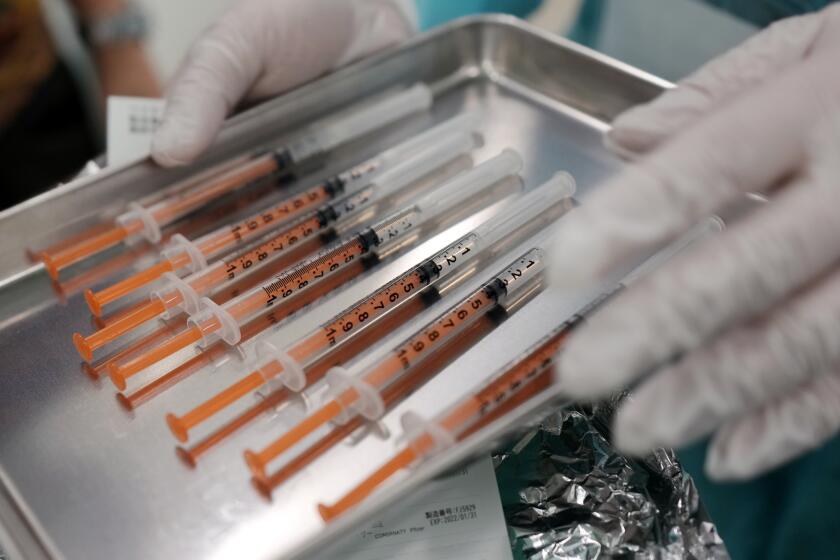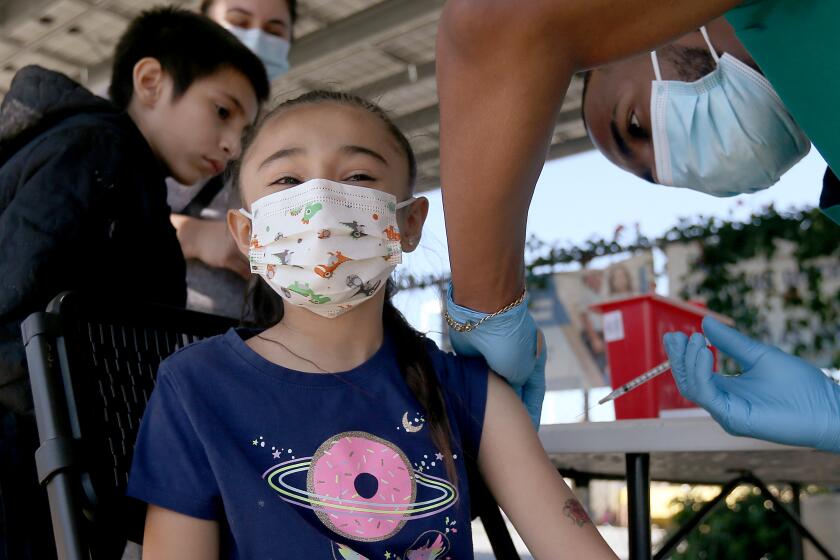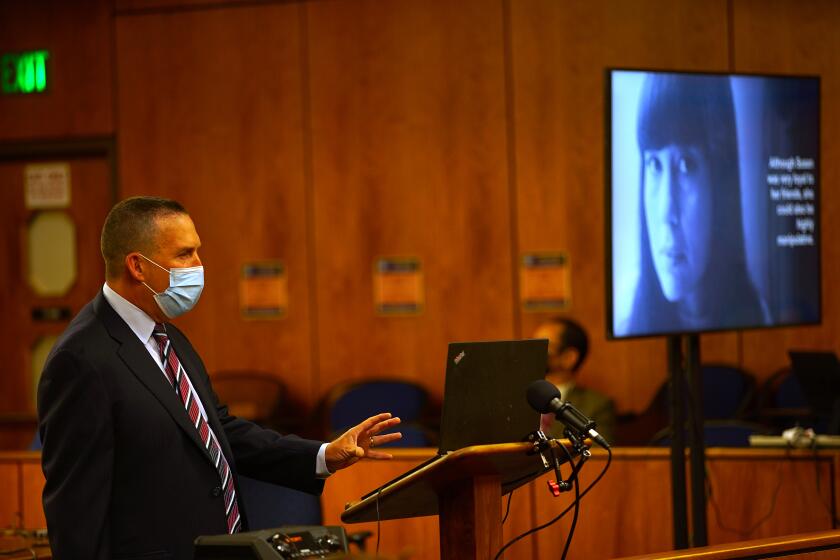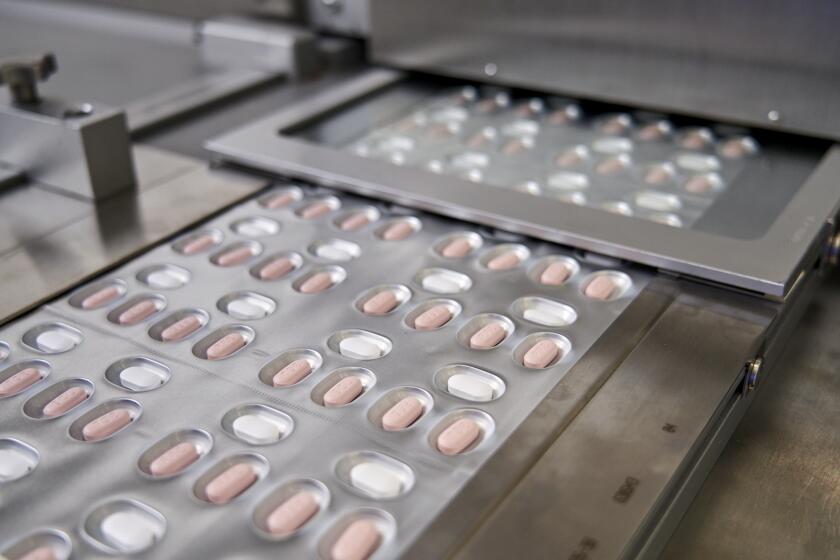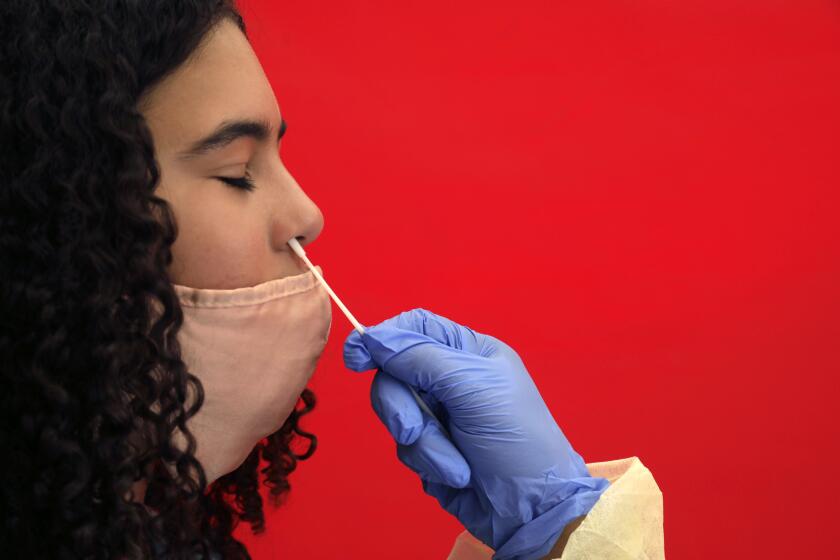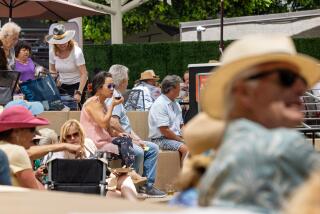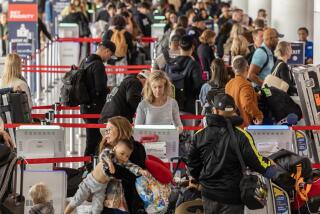Infectious Omicron BA.2 now dominant in U.S., with coronavirus spring rise likely
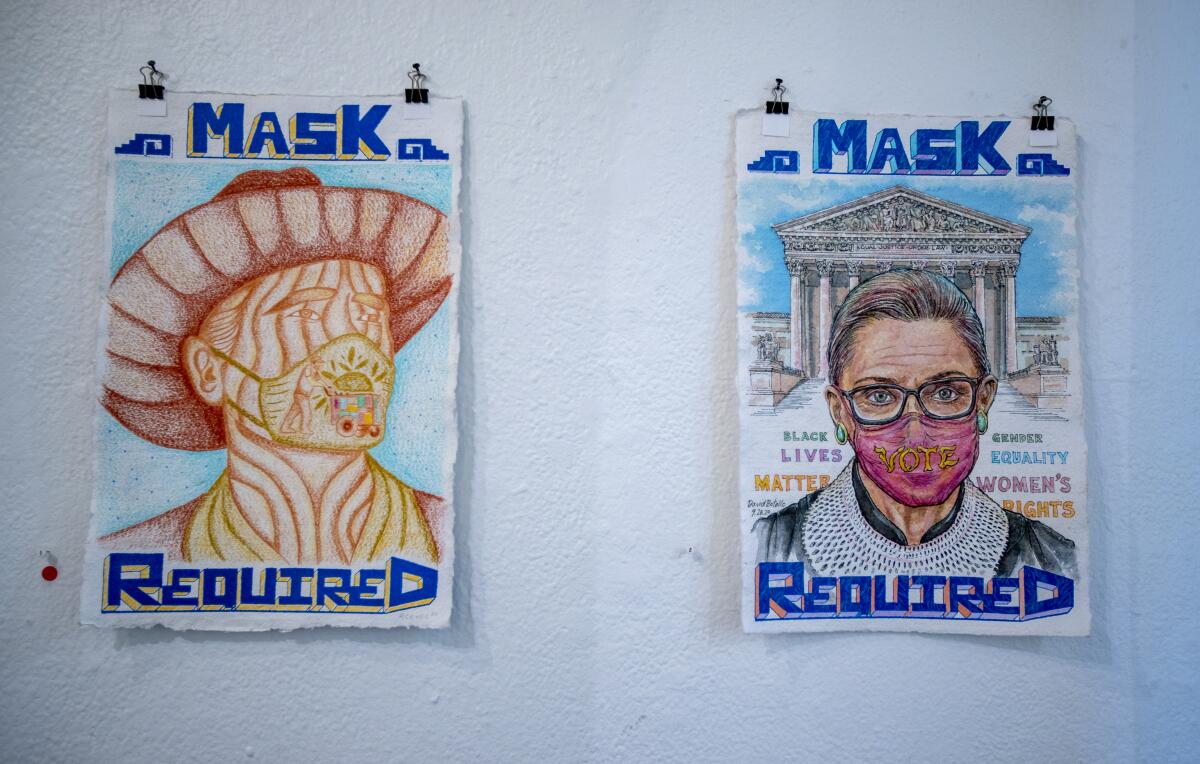
- Share via
The highly infectious BA.2 Omicron subvariant is now the dominant version of the coronavirus circulating in the United States, according to federal estimates, a development that is triggering fresh concerns of a potential springtime wave.
How big that potential upswing might prove to be remains the subject of much debate. Some experts believe California is well-armored against another significant surge — largely because the vast majority of residents have either been vaccinated or likely have some natural immunity left over from a recent infection.
But BA.2 has fueled substantial increases in other countries, demonstrating how readily the super-contagious subvariant can still spread.
“We will have a wave. The only question is how big it will be,” tweeted Dr. Eric Topol, director of the Scripps Research Translational Institute in La Jolla.
Added Scripps microbiologist Kristian Andersen: “I expect we’ll see a wave — I don’t know if it’ll be a surge.”
The FDA has authorized another booster dose of Pfizer and Moderna’s COVID-19 vaccines for people age 50 and up, and the CDC endorsed the decision.
Over the week ending Saturday, BA.2 made up an estimated 55% of samples, according to the U.S. Centers for Disease Control and Prevention. That’s up from 39% the previous week.
In the Southwestern U.S. — which includes California, Arizona, Nevada and Hawaii — BA.2 made up an estimated 60.5% of coronavirus samples over the same week. The week before, the share was 45%.
Overall, the number of coronavirus cases reported day over day is continuing to drop in California. But since BA.2 is believed to be 30% to 60% more contagious than the first dominant Omicron subvariant, BA.1, it’s not a given that the trend will endure.
According to a new study — not yet peer-reviewed and posted online Sunday — from Sweden that analyzed swab samples, the levels of coronavirus found in noses with BA.2 were nearly twice as high as in noses with BA.1.
“Higher viral load in the upper pharynx may at least partially explain why Omicron BA.2 is more contagious than the BA.1 lineage,” the study said.
A Mexican immigrant is a foot soldier in the drive by nonprofits and healthcare providers to close the Latino COVID-19 vaccination gap in Orange County.
There are eight states that have shown at least a 10% increase in coronavirus cases in the last two weeks, Topol tweeted Sunday. And the national test positivity rate — the percentage of which coronavirus tests analyzed in labs come back positive — is now around 3%, up from 2.1% in March, he added.
In analyzing the wastewater of San Diego County, California’s second most populous, BA.2 is now the dominant subvariant in sewage, Andersen tweeted recently, suggesting that “almost all new infections are due to BA.2 in San Diego.” That makes it all the more important for vaccinated people who haven’t gotten their first booster shot to get it now, and to stock up on rapid tests, Andersen added.
That’s not to say that alarm bells should be ringing, however. Dr. Robert Kim-Farley, a UCLA epidemiologist and infectious disease expert, said he expects the likely scenario for California in the coming weeks is either a mild increase in coronavirus cases or a leveled-off decrease.
Kim-Farley doesn’t expect a major surge in California, “just because so many people are immune, due to vaccination or to natural immunity from a recent infection.” He has said he’d be more concerned about a new variant that would render existing immunizations and natural immunity less effective.
The U.S. Food and Drug Administration on Tuesday authorized a second booster for adults 50 and older — which would be the fourth dose for those who originally got the Pfizer or Moderna vaccines, and the third dose for those who originally got the Johnson & Johnson vaccine. The U.S. Centers for Disease Control and Prevention issued similar guidance hours later.
The second booster may be given any time starting four months after the first booster.
“Current evidence suggests some waning of protection over time against serious outcomes from COVID-19 in older and immunocompromised individuals,” Dr. Peter Marks, director of the FDA’s Center for Biologics Evaluation and Research, said in a statement. “Based on an analysis of emerging data, a second booster dose of either the Pfizer-BioNTech or Moderna COVID-19 vaccine could help increase protection levels for these higher-risk individuals.”
Getting a second booster, said CDC Director Dr. Rochelle Walensky in a statement, “is especially important for those 65 and older, and those 50 and older with underlying medical conditions that increase their risk for severe disease from COVID-19, as they are the most likely to benefit from receiving an additional booster dose at this time.”
Federal agencies will continue to evaluate the need for a second booster shot for all Americans, Walensky said.
The CDC has already recommended that those age 12 and older with moderate or severely compromised immune systems who originally got the Pfizer or Moderna vaccination series get a fourth dose of vaccine, and those who originally got the single-shot Johnson & Johnson vaccine to get two additional doses.
Kim-Farley said the federal action was appropriate.
“We do note waning immunity following the third dose. And in some studies, a fourth dose has been able to bring the antibody level back up to what it was shortly after the third dose. That would imply additional protection,” Kim-Farley said in an interview.
Vaccines and boosters proved highly effective against serious illness from Omicron. But what is also clear is that the defense afforded by vaccines wanes over time.
It’s most important for the unvaccinated to get their shots, and those who haven’t even gotten their first booster to get that injection, Kim-Farley said. Only 30% of L.A. County’s 900,000 children age 5 to 11 are considered fully vaccinated, and just 62% of its 1.4 million seniors have received their first booster shot.
It would be more likely that L.A. County would avoid a new springtime surge if more people got their shots, Kim-Farley said. “The fourth dose will be especially helpful for those who are at higher risk of severe disease or death,” Kim-Farley said.
Dr. Peter Chin-Hong, a UC San Francisco infectious diseases expert, said in an interview that if he were advising his relatives, he might want those age 65 and older — and especially those 75 and older — to get the second booster shot.
Like Kim-Farley, Chin-Hong said he doesn’t think BA.2 will do much damage to California in the next few weeks, relatively speaking, given that the weather is milder than it has been in the Northeast, allowing people to socialize outdoors. But Chin-Hong suggested the fourth dose for people for whom you “don’t want to take any chances” with getting infected.
Getting a second booster shot is less urgent for a relatively healthy person in their 50s, Chin-Hong said. But a second booster shot would allow them to get an antibody boost that may help “protect them against getting a breakthrough infection,” Chin-Hong said.
As of mid-March, only 30% of children ages 5 to 11 were fully vaccinated in Los Angeles County
Such a fourth dose might be helpful for people who are traveling to, say, a wedding or another country, and want to take additional steps to avoid getting infected.
It will still take more time for researchers to determine how much additional benefit people will get from a fourth dose of vaccine. Clearly, there’s a big benefit after a second dose of vaccine, and again following a booster, Chin-Hong said. Early data from Israel, however, suggest the additional benefit after the fourth dose isn’t as substantial.
But a fourth dose may still be worth getting, especially for older people for whom that additional dose could be life-saving. The fourth dose is safe, Chin-Hong said: “You don’t get immune exhaustion, you don’t get more side effects. It’s well-tolerated.”
At UC San Francisco’s flagship hospital at Parnassus Heights, coronavirus-positive patients remain quite low. As of Monday, there were just four coronavirus-positive patients, with none on ventilators; on one day in late January, there were 95 coronavirus-positive patients, with 12 of them on ventilators.
The court had previously held onto its mandate for everyone, regardless of vaccination status, after the county loosened its rules.
More also needs to be done to promote broader public understanding of anti-COVID drugs like Paxlovid, Chin-Hong added, which is taken orally and can reduce the risk of severe COVID-19 by as much as 89%.
Some points of concern involve some recent setbacks. First, one of the five anti-COVID drugs that treats a new coronavirus infection, sotrovimab, is probably ineffective against BA.2, and the FDA on Friday said that drug is no longer authorized for use in New England, New York and New Jersey.
Second, the inability of Congress to approve new funding for community groups to vaccinate Americans — especially those who are uninsured — is a big problem that could worsen efforts to inoculate and give booster shots to many people living in vulnerable communities, Chin-Hong said.
In an interview Sunday on the BBC, Dr. Anthony Fauci, President Biden’s chief medical advisor, said the U.S. is still headed in the right direction, with hospitalizations and deaths still declining. He added he wouldn’t be surprised if there will eventually be an intermittent booster COVID-19 booster shot made available regularly, similar to the flu shot.
“We are going, in a gradual way, towards what we all hoped would be normal,” Fauci said.
“Having said that, we need to be prepared for the possibility that we would have another variant that would come along … that does give us an uptick in cases and hospitalization,” Fauci said. If that happens, “we should be prepared and flexible enough to pivot towards going back, at least temporarily, to a more rigid type of restriction such as requiring masks indoors.”
Remember all those problems we had with vaccine equity? Now they’re cropping up with new COVID-19 medications that are in short supply.
So far, a BA.2-fueled surge has yet to materialize nationally. However, there are some indications that the country’s progress in shaking off the winter’s Omicron wave has slowed.
The rolling average of newly reported coronavirus cases has hovered between 27,000 and 28,000 a day for the better part of two weeks, according to the CDC. That’s still more than double the pre-Delta surge lows of fewer than 10,000 cases a day nearly one year ago.
California is seeing a similar trend — averaging about 2,600 to 4,300 cases a day over the same period. But even though cases are no longer falling rapidly, the current reported level of daily infection is still the lowest seen statewide since last July.
And in L.A. County, the drop in coronavirus case rates has only recently seemed to flatten. According to the county’s tally, the average is about 680 coronavirus cases a day, equivalent to a rate of 47 weekly cases per 100,000 residents, putting the area in a zone of moderate coronavirus transmission.
The California COVID Assessment Tool, published by the state Department of Public Health, estimates that the state’s effective transmission rate is 0.87. A rate below 1.0 means each infected Californian is transmitting the virus to fewer than one person, on average, and indicates the virus’ spread is decreasing.
The number of coronavirus-positive people being cared for in California’s hospitals has also declined markedly over the past few months. As of Sunday, 1,470 such patients were receiving professional care statewide, less than 10% of January’s Omicron-era peak.
New York has often offered a hint for what California will face weeks later, and that city is reporting an uptick in coronavirus cases. New York City is reporting about 93 weekly cases per 100,000 residents; that’s up from 53 weekly cases for every 100,000 residents a month ago. Those are rates representative of substantial transmission, but even the latest number represents less than 3% of the Omicron peak around New Year’s Day.
Coronavirus-related hospitalizations and deaths in New York City, however, are still declining.
California has sent millions of at-home COVID-19 tests to schools in preparation for the return of students from spring break.
Given the stark declines in cases and hospitalizations, California has lifted virtually all state-level mask mandates — save for in certain settings, such as hospitals. Come Friday, the state will also rescind its requirement that attendees show proof they’ve been vaccinated for COVID-19 or recently tested negative for the coronavirus as a condition of entering indoor events with more than 1,000 people.
Officials at the local level, which have the option of keeping rules in place that are stricter than the state’s if they so choose, have also shown increased willingness to remove pandemic-inspired measures. The Los Angeles City Council this week is expected to officially lift vaccine verification requirements at many indoor businesses.
But even though current trendlines are promising, California health officials have said they anticipate and are actively positioning for the possibility of future COVID-19 spikes — particularly later in the summer and around the fall-and-winter holiday season, as that’s when the coronavirus has previously surged.
Last month, health officials unveiled a seven-pronged COVID-19 preparedness blueprint that, among other things, calls for the state to maintain the capacity to administer hundreds of thousands of vaccine doses and coronavirus tests per day, provide ready access to therapeutics and stockpile a robust supply of high-quality masks.
“We’re going to be ready, late summer, early fall when we’ve seen each of the last two years increasing cases. We’re going to be extra ready ... between Thanksgiving and New Year’s, when we’ve seen the highest rise in cases,” Dr. Mark Ghaly, California’s health and human services secretary, said during an appearance last week on the Johns Hopkins Bloomberg School of Public Health’s “Public Health On Call” podcast.
More to Read
Sign up for Essential California
The most important California stories and recommendations in your inbox every morning.
You may occasionally receive promotional content from the Los Angeles Times.
